An Overview of the Geomorphological Characteristics of the Pergamon Micro-Region (Bakırçay and Madra River Catchments, Aegean Region, West Turkey)
Abstract
:1. Introduction
2. Natural Characteristics of the Pergamon Micro-Region
2.1. Geographical Setting
2.2. Tectonics, Bedrock, and Soil
2.3. Climate
2.4. Vegetation
3. Materials and Methods
3.1. Survey of Geomorphological Features
3.2. Extraction of Basic Geomorphometric Parameters
4. Results
4.1. General Geomorphological Characteristics
4.2. Major Geomorphological Units
4.2.1. Geomorphological Unit 1—Kara Dağı Mountains
4.2.2. Geomorphological Unit 2—Northern Highlands
4.2.3. Geomorphological Unit 3—Yunt Dağı Mountains
4.2.4. Geomorphological Unit 4—Plains
5. Discussion
5.1. Development of the Major Landform Units
5.2. Usage Suitability and Human Impact during the Late Holocene
6. Conclusions
Supplementary Materials
Author Contributions
Funding
Acknowledgments
Conflicts of Interest
References
- Kayan, İ. Holocene stratigraphy and geomorphological evolution of the Aegean coastal plains of Anatolia. Quat. Sci. Rev. 1999, 18, 541–548. [Google Scholar] [CrossRef]
- Kayan, İ.; Vardar, S. Geomorphological formation and development of the delta plain of the Madra River. In The Madra River Delta: Regional Studies on the Aegean Coast of Turkey 1: Environment, Society and Community from Prehistory to the Present; Lambrianides, K., Spencer, N., Eds.; The British Institute at Ankara: London, UK, 2007; Volume 35, pp. 23–30. [Google Scholar]
- Kuzucuoğlu, C.; Çiner, A.; Kazancı, N. (Eds.) The Geomorphological Regions of Turkey. In Landscapes and Landforms of Turkey; Springer: Cham, Switzerland, 2019; pp. 41–178. [Google Scholar]
- Kraft, J.C.; Kayan, İ.; Erol, O. Geomorphic Reconstructions in the Environs of Ancient Troy. Science 1980, 209, 776–782. [Google Scholar] [CrossRef]
- Kayan, İ. Bronze Age Regression and Change of Sedimentation on The Aegean Coastal Plains of Anatolia (Turkey). In Third Millennium BC Climate Change and Old World Collapse; Dalfes, H.N., Kukla, G., Weiss, H., Eds.; Springer: Berlin/Heidelberg, Germany, 1997; Volume 49, pp. 431–450. [Google Scholar]
- Kraft, J.C.; Rapp, G.; Kayan, İ.; Luce, J.V. Harbor areas at ancient Troy: Sedimentology and geomorphology complement Homer’s Iliad. Geology 2003, 31, 163–166. [Google Scholar] [CrossRef]
- Kayan, İ. Landscape Development and Changing Environment of Troia (North-western Anatolia). In Landscapes and Landforms of Turkey; Kuzucuoğlu, C., Çiner, A., Kazancı, N., Eds.; Springer: Cham, Switzerland, 2019; pp. 277–291. [Google Scholar]
- Schneider, S.; Nykamp, M.; Matthaei, A.; Bebermeier, W.; Schütt, B. Alluvial geoarchaeology of a small drainage basin in western Anatolia: Late Holocene landscape development and the question of the mouth of the Paleo-Bakırçay. Quat. Int. 2013, 312, 84–95. [Google Scholar] [CrossRef]
- Schneider, S.; Matthaei, A.; Bebermeier, W.; Schütt, B. Late Holocene human–environmental interactions in the Eastern Mediterranean: Settlement history and paleogeography of an ancient Aegean hill-top settlement. Quat. Int. 2014, 324, 84–98. [Google Scholar] [CrossRef]
- Schneider, S.; Matthaei, A.; Schlöffel, M.; Meyer, C.; Kronwald, M.; Pint, A.; Schütt, B. A geoarchaeological case study in the chora of Pergamon, western Turkey, to reconstruct the late Holocene landscape development and settlement history. Quat. Int. 2015, 367, 62–76. [Google Scholar] [CrossRef]
- Schneider, S.; Schlöffel, M.; Schwall, C.; Horejs, B.; Schütt, B. First stratigraphic evidence and absolute dating of a Bronze Age settlement in the Bakırçay valley in western Turkey. J. Archaeol. Sci. Rep. 2017, 12, 316–322. [Google Scholar] [CrossRef]
- Knitter, D.; Blum, H.; Horejs, B.; Nakoinz, O.; Schütt, B.; Meyer, M. Integrated centrality analysis: A diachronic comparison of selected Western Anatolian locations. Quat. Int. 2013, 312, 45–56. [Google Scholar] [CrossRef]
- Kraft, J.C.; Bückner, H.; Kayan, İ.; Engelmann, H. The geographies of Ancient Ephesus and the Artemision in Anatolia. Geoarchaeology 2007, 22, 121–149. [Google Scholar] [CrossRef]
- Kraft, J.C.; Rapp, G.; Brükner, H.; Kayan, İ. Results of the struggle at ancient Ephesus: Natural processes 1, human intervention 0. Geol. Soc. Lond. Spec. Publ. 2011, 352, 27–36. [Google Scholar] [CrossRef]
- Stock, F.; Pint, A.; Horejs, B.; Ladstätter, S.; Brückner, H. In search of the harbours: New evidence of Late Roman and Byzantine harbours of Ephesus. Quat. Int. 2013, 312, 57–69. [Google Scholar] [CrossRef]
- Brückner, H.; Müllenhoff, M.; Gehrels, R.; Herda, A.; Knipping, M.; Vött, A. From Archipelago to Floodplain–Geographical and Ecological Changes in Miletus and its Environs During the Last Six Millennia (Western Anatolia, Turkey). Z. Geomorphol. 2006, 142, 63–83. [Google Scholar]
- Ludwig, B. Reconstructing the Ancient Route Network in Pergamon’s Surroundings. Land 2020, 9, 241. [Google Scholar] [CrossRef]
- Knitter, D. Central Places and the Environment. Investigations of an Interdependent Relationship. Doctoral Thesis, Freie Universität Berlin, Berlin, Germany, 2013. [Google Scholar]
- Horejs, B. Bergama and the Bakırçay Valley in Prehistory. In Proceedings of International Bergama Symposium; Önen, E., Mutluer, M., Çetin, N., Eds.; Bergama Belediyesi: Bergama, İzmir, 2011; pp. 24–36. [Google Scholar]
- Radt, W. Pergamon: Geschichte und Bauten Einer Antiken Metropol; Primus Verlag: Darmstadt, Germany, 2016. [Google Scholar]
- Yilmaz, H.; Oyman, T.; Arehart, G.B.; Colakoglu, A.R.; Billor, Z. Low-sulfidation type Au–Ag mineralization at Bergama, Izmir, Turkey. Ore Geol. Rev. 2007, 32, 81–124. [Google Scholar] [CrossRef]
- Russell, B. Gazetteer of Stone Quarries in the Roman World; Version 1.0; Oxford University Press: Oxford, UK, 2013; p. 6. Available online: Oxrep.classics.ox.ac.uk/databases/stone_quarries_database/ (accessed on 20 December 2020).
- Rizzoli, P.; Martone, M.; Gonzalez, C.; Wecklich, C.; Borla Tridon, D.; Bräutigam, B.; Bachmann, M.; Schulze, D.; Fritz, T.; Huber, M.; et al. Generation and performance assessment of the global TanDEM-X digital elevation model. ISPRS J. Photogramm. Remote Sens. 2017, 132, 119–139. [Google Scholar] [CrossRef] [Green Version]
- Wessel, B.; Huber, M.; Wohlfart, C.; Marschalk, U.; Kosmann, D.; Roth, A. Accuracy assessment of the global TanDEM-X Digital Elevation Model with GPS data. ISPRS J. Photogramm. Remote Sens. 2018, 139, 171–182. [Google Scholar] [CrossRef]
- Okay, A. Geology of Turkey: A Synopsis. Anschitt 2008, 21, 19–42. [Google Scholar]
- Pavúk, P.; Horejs, B. Ceramics, Surveys, and Connectivity in Western Anatolia: The Middle and Late Bronze Age Bakirçay/Kaikos Valley Restudied. Ägypten Levante 2018, 457–485. [Google Scholar] [CrossRef]
- Pirson, F. Stadt und Umland von Pergamon. Stand der Forschung und Perspektiven. In Anatolien—Brücke der Kulturen; Yalçın, Ü., Bienert, H.D., Eds.; Bochum: Bonn, Germany, 2015; pp. 289–310. [Google Scholar]
- Laabs, J.; Knitter, D. How Much Is Enough? First Steps to a Social Ecology of the Pergamon Microregion. Land 2021, 10, 479. [Google Scholar] [CrossRef]
- Lolling, H. Atarneus. Mitt. Dtsch. Archäol. Inst. Athen. Abt. 1879, 4, 1–10. [Google Scholar]
- Philippson, A. Geographisch-geologische Übersicht der Landschaft. In Altertümer von Pergamon: Stadt und Landschaft; Conze, A., Ed.; Verlag von Georg Reimer: Berlin, Germany, 1912; pp. 43–58. [Google Scholar]
- Pirson, F.; Horejs, B.; Laufer, E.; Schwall, C.; Schwarz, A.J. Pergamon—Bericht über die Arbeiten in der Kampagne 2015. Archäol. Anz. 2016, 2, 135–223. [Google Scholar]
- Horejs, B. Bronzezeitliche Besiedlungsmuster im Kaikostal. Interpretationen erster Surveyergebnisse im Umland von Pergamon (Türkei). In Siedlung und Handwerk—Studien zu Sozialen Kontexten in der Bronzezeit; Horejs, B., Kienlin, T.L., Eds.; Verlag Dr. Rudolf Habelt: Bonn, Germany, 2010; Volume 194, pp. 47–67. [Google Scholar]
- Sommerey, K.M. Die Chora von Pergamon: Studien zu Grenzen, Siedlungsstruktur und Wirtschaft. In Istanbuler Mitteilungen; Pirson, F., Bachmann, M., Eds.; Ernst Wasmuth: Tübingen, Germany, 2008; Volume 58, pp. 135–170. [Google Scholar]
- Kökten, K. 1949 yılı tarih öncesi araştırmaları hakkında kısa rapor. Belleten 1949, 13, 811–831. [Google Scholar]
- Pint, A.; Seeliger, M.; Frenzel, P.; Feuser, S.; Erkul, E.; Berndt, C.; Klein, C.; Pirson, F.; Brückner, H. The environs of Elaia’s ancient open harbour—A reconstruction based on microfaunal evidence. J. Archaeol. Sci. 2015, 54, 340–355. [Google Scholar] [CrossRef]
- Seeliger, M.; Bartz, M.; Erkul, E.; Feuser, S.; Kelterbaum, D.; Klein, C.; Pirson, F.; Vött, A.; Brückner, H. Taken from the sea, reclaimed by the sea: The fate of the closed harbour of Elaia, the maritime satellite city of Pergamum (Turkey). Quat. Int. 2013, 312, 70–83. [Google Scholar] [CrossRef]
- Seeliger, M.; Brill, D.; Feuser, S.; Bartz, M.; Erkul, E.; Kelterbaum, D.; Vött, A.; Klein, C.; Pirson, F.; Brückner, H. The Purpose and Age of Underwater Walls in the Bay of Elaia of Western Turkey: A Multidisciplinary Approach. Geoarchaeology 2014, 29, 138–155. [Google Scholar] [CrossRef]
- Seeliger, M.; Pint, A.; Feuser, S.; Riedesel, S.; Marriner, N.; Frenzel, P.; Pirson, F.; Bolten, A.; Brückner, H. Elaia, Pergamon’s maritime satellite: The rise and fall of an ancient harbour city shaped by shoreline migration. J. Quat. Sci. 2019, 34, 228–244. [Google Scholar] [CrossRef] [Green Version]
- Seeliger, M.; Pint, A.; Frenzel, P.; Feuser, S.; Pirson, F.; Riedesel, S.; Brückner, H. Foraminifera as markers of Holocene sea-level fluctuations and water depths of ancient harbours—A case study from the Bay of Elaia (W Turkey). Palaeogeogr. Palaeoclimatol. Palaeoecol. 2017, 482, 17–29. [Google Scholar] [CrossRef]
- Shumilovskikh, L.S.; Seeliger, M.; Feuser, S.; Novenko, E.; Schlütz, F.; Pint, A.; Pirson, F.; Brückner, H. The harbour of Elaia: A palynological archive for human environmental interactions during the last 7500 years. Quat. Sci. Rev. 2016, 149, 167–187. [Google Scholar] [CrossRef]
- Mecking, R.; Meinecke, M.; Erkul, E.; Driehaus, B.; Bolten, A.; Pirson, F.; Rabbel, W. The Yığma Tepe of Pergamon: Stratigraphic construction of a monumental tumulus from seismic refraction measurements. Archaeol. Prospect. 2020, 27, 73–105. [Google Scholar] [CrossRef]
- Becker, F.; Knitter, D.; Nykamp, M.; Schütt, B. Meta-Analysis of Geomorphodynamics in the Western Lower Bakırçay Plain (Aegean Region, Turkey). Land 2020, 9, 338. [Google Scholar] [CrossRef]
- Lambrianides, K.; Spencer, N. The Madra River Delta: Regional Studies on the Aegean Coast of Turkey 1: Environment, Society and Community from Prehistory to the Present; The British Institute at Ankara: London, UK, 2007; Volume 35. [Google Scholar]
- Pirson, F. Pergamon—Bericht über die Arbeiten in der Kampagne 2018. Archäol. Anz. 2019, 2, 1–157. [Google Scholar] [CrossRef]
- Yilmaz, Y.; Genç, Ş.C.; Gürer, F.; Bozcu, M.; Yilmaz, K.; Karacik, Z.; Altunkaynak, Ş.; Elmas, A. When did the western Anatolian grabens begin to develop? In Tectonics and Magmatism in Turkey and the Surrounding Area; Bozkurt, E., Winchester, J.A., Piper, J.D.A., Eds.; Geological Society of London: London, UK, 2000; Volume 173, pp. 353–384. [Google Scholar]
- İnci, U. Depositional evolution of Miocene coal successions in the Soma coalfield, western Turkey. Int. J. Coal Geol. 2002, 51, 1–29. [Google Scholar] [CrossRef]
- Kaya, O.; Ünay, E.n.; Göktaş, F.k.; Saraç, G. Early Miocene stratigraphy of central west Anatolia, Turkey: Implications for the tectonic evolution of the eastern Aegean area. Geol. J. 2007, 42, 85–109. [Google Scholar] [CrossRef]
- Sanğu, E.; Gürer, Ö.F.; Gürer, A. Fault kinematic and Plio-Quaternary paleostress evolution of the Bakırçay Basin, Western Turkey. Int. Geol. Rev. 2020, 62, 1245–1261. [Google Scholar] [CrossRef]
- Karacik, Z.; Yilmaz, Y.; Pearce, J. The Dikili-Çandarlı Volcanics, Western Turkey: Magmatic Interactions as Recorded by Petrographic and Geochemical Features. Turk. J. Earth Sci. 2007, 16, 493–522. [Google Scholar]
- Borsi, S.; Ferrara, G.; Innocenti, F.; Mazzuoli, R. Geochronology and petrology of recent volcanics in the eastern Aegean Sea (West Anatolia and Lesvos Island). Bull. Volcanol. 1972, 36, 473–496. [Google Scholar] [CrossRef]
- Kuzucuoğlu, C. River response to Quaternary tectonics with examples from northwestern Anatolia, Turkey. In Mediterranean Quaternary River Environments; Lewin, J., Macklin, M.G., Woodward, J.C., Eds.; Balkema: Rotterdam, The Netherlands, 1995; pp. 45–53. [Google Scholar]
- Baartman, J.; Masselink, R.; Keesstra, S.; Temme, A. Linking landscape morphological complexity and sediment connectivity. Earth Surf. Process. Landf. 2013, 38, 1457–1471. [Google Scholar] [CrossRef]
- Fryirs, K.A.; Brierley, G.J.; Preston, N.J.; Kasai, M. Buffers, barriers and blankets: The (dis)connectivity of catchment-scale sediment cascades. Catena 2007, 70, 49–67. [Google Scholar] [CrossRef]
- Fryirs, K. (Dis)Connectivity in catchment sediment cascades: A fresh look at the sediment delivery problem. Earth Surf. Process. Landf. 2013, 38, 30–46. [Google Scholar] [CrossRef]
- Finné, M.; Woodbridge, J.; Labuhn, I.; Roberts, C.N. Holocene hydro-climatic variability in the Mediterranean: A synthetic multi-proxy reconstruction. Holocene 2019, 29, 847–863. [Google Scholar] [CrossRef]
- Dusar, B.; Verstraeten, G.; Notebaert, B.; Bakker, J. Holocene environmental change and its impact on sediment dynamics in the Eastern Mediterranean. Earth Sci. Rev. 2011, 108, 137–157. [Google Scholar] [CrossRef]
- Roberts, C.N.; Woodbridge, J.; Palmisano, A.; Bevan, A.; Fyfe, R.; Shennan, S. Mediterranean landscape change during the Holocene: Synthesis, comparison and regional trends in population, land cover and climate. Holocene 2019, 29, 923–937. [Google Scholar] [CrossRef]
- Tassios, T.P. Water supply of ancient Greek cities. Water Supply 2007, 7, 165–172. [Google Scholar] [CrossRef]
- Macklin, M.; Lewin, J.; Woodward, J. (Eds.) Quaternary fluvial systems in the Mediterranean basin. In Mediterranean Quaternary River Environments; Balkema: Rotterdam, The Netherlands, 1995; pp. 1–25. [Google Scholar]
- MTA. Geological Map of Turkey, 1:500,000 (İzmir); General Directorate of Mineral Research and Exploration: Ankara, Turkey, 2002. [Google Scholar]
- Aksu, A.E.; Piper, D.J.W.; Konuk, T. Late Quaternary tectonic and sedimentary history of outer Izmir and Candarli bays, western Turkey. Mar. Geol. 1987, 76, 89–104. [Google Scholar] [CrossRef]
- Kayan, İ. Late Holocene sea-level changes on the western Anatolian coast. Palaeogeogr. Palaeoclimatol. Palaeoecol. 1988, 68, 205–218. [Google Scholar] [CrossRef]
- Aksu, A.E.; Konuk, T.; Uluğ, A.; Duman, M.; Piper, D.J.W. Quaternary tectonic and sedimentary history of eastern Aegean Sea shelf area. Jeofizik 1990, 4, 3–35. [Google Scholar]
- Vacchi, M.; Rovere, A.; Chatzipetros, A.; Zouros, N.; Firpo, M. An updated database of Holocene relative sea level changes in NE Aegean Sea. Quat. Int. 2014, 328–329, 301–310. [Google Scholar] [CrossRef]
- Kuzucuoğlu, C.; Celâl Şengör, A.M.; Çiner, A. The Tectonic Control on the Geomorphological Landscapes of Turkey. In Landscapes and Landforms of Turkey; Kuzucuoğlu, C., Çiner, A., Kazancı, N., Eds.; Springer: Cham, Switzerland, 2019; pp. 17–40. [Google Scholar]
- Altunkaynak, Ş.; Yılmaz, Y. The Mount Kozak magmatic complex, Western Anatolia. J. Volcanol. Geotherm. Res. 1998, 85, 211–231. [Google Scholar] [CrossRef]
- Emre, Ö.; Özalp, S.; Dogan, A.; Özaksoy, V.; Yildirim, C.; Göktas, F. Izmir Yakın Çevresinin diri Fayları ve Deprem Potansiyelleri (Active Faults and Earthquake Potential in the Izmir Region); General Directorate of Mineral Research and Exploration (MTA Rapor No: 10754): Ankara, Turkey, 2005. [Google Scholar]
- Paradisopoulou, P.M.; Papadimitriou, E.E.; Karakostas, V.G.; Taymaz, T.; Kilias, A.; Yolsal, S. Seismic Hazard Evaluation in Western Turkey as Revealed by Stress Transfer and Time-dependent Probability Calculations. Pure Appl. Geophys. 2010, 167, 1013–1048. [Google Scholar] [CrossRef]
- Emre, Ö.; Doğan, A. 1:250,000 Scale Active Fault Map Series of Turkey, Ayvalık (NJ 35-2) Quadrangle; Serial Number: 2; General Directorate of Mineral Research and Exploration: Ankara, Turkey, 2010. [Google Scholar]
- Emre, Ö.; Doğan, A.; Özalp, S. 1:250,000 Scale Active Fault Map Series of Turkey, Balıkesir (NJ 35-3) Quadrangle; Serial Number: 4; General Directorate of Mineral Research and Exploration: Ankara, Turkey, 2011. [Google Scholar]
- Emre, Ö.; Özalp, S. 1:250,000 Scale Active Fault Map Series of Turkey, Urla (NJ 35-6) Quadrangle; Serial Number: 5; General Directorate of Mineral Research and Exploration: Ankara, Turkey, 2011. [Google Scholar]
- Emre, Ö.; Özalp, S.; Duman, T.Y. 1:250,000 Scale Active Fault Map Series of Turkey, İzmir (NJ 35-7) Quadrangle; Serial Number: 6; General Directorate of Mineral Research and Exploration: Ankara, Turkey, 2011. [Google Scholar]
- Ölgen, K. Determining lineaments and geomorphic features using Landsat 5-TM data on lower Bakırçay plain, Western Turkey. Aegean Geogr. J. 2004, 13, 47–57. [Google Scholar]
- Erlat, E. Climatic conditions in Altınova and the Madra River Delta. In The Madra River Delta: Regional Studies on the Aegean Coast of Turkey 1: Environment, Society and Community from Prehistory to the Present; Lambrianides, K., Spencer, N., Eds.; The British Institute at Ankara: London, UK, 2007; Volume 35, pp. 51–59. [Google Scholar]
- Danacıoğlu, S.; Tağıl, Ş. Evaluation of the erosion risk by using the RUSLE model in Bakırçay basin. Balıkesir Üniv. Sos. Bilim. Enst. Derg. 2017, 20, 1–18. (In Turkish) [Google Scholar]
- Kapur, S.; Akça, E.; Günal, H. The Soils of Turkey; Springer: Cham, Switzerland, 2017. [Google Scholar]
- Akman, Y.; Ketenoǧlu, O. The climate and vegetation of Turkey. Proc. R. Soc. Edinb. 1986, 89B, 123–134. [Google Scholar] [CrossRef]
- Peel, M.C.; Finlayson, B.L.; McMahon, T.A. Updated world map of the Köppen-Geiger climate classification. Hydrol. Earth Syst. Sci. 2007, 11, 1633–1644. [Google Scholar] [CrossRef] [Green Version]
- Harris, I.; Jones, P.D.; Osborn, T.J.; Lister, D.H. Updated high-resolution grids of monthly climatic observations—The CRU TS3.10 Dataset. Int. J. Climatol. 2014, 34, 623–642. [Google Scholar] [CrossRef] [Green Version]
- Rohling, E.J.; Marino, G.; Grant, K.M.; Mayewski, P.A.; Weninger, B. A model for archaeologically relevant Holocene climate impacts in the Aegean-Levantine region (easternmost Mediterranean). Quat. Sci. Rev. 2019, 208, 38–53. [Google Scholar] [CrossRef] [Green Version]
- Cole, B.; Smith, G.; Balzter, H. Acceleration and fragmentation of CORINE land cover changes in the United Kingdom from 2006–2012 detected by Copernicus IMAGE2012 satellite data. Int. J. Appl. Earth Obs. Geoinf. 2018, 73, 107–122. [Google Scholar] [CrossRef]
- QGIS Development Team. QGIS Geographic Information System; Open Source Geospatial Foundation Project: Beaverton, OR, USA, 2020. [Google Scholar]
- Walstra, J.; Heyvaert, V.; Verkinderen, P. Remote sensing for the study of fluvial landscapes in Lower Khuzestan, SW Iran. In Developments in Earth Surface Processes; Elsevier: Leicester, UK, 2009; Volume 15. [Google Scholar]
- Hengl, T.; Reuter, H.I. Geomorphometry—Concepts, Software, Applications. In Developments in Soil Science; Hartemink, A.E., McBratney, A.B., Eds.; Elsevier: Amsterdam, The Netherlands, 2009; Volume 33, pp. 1–796. [Google Scholar]
- GRASS Development Team. Geographic Resources Analysis Support System (GRASS) Software; Version 7.8; Open Source Geospatial Foundation: Beaverton, OR, USA, 2020. [Google Scholar]
- Conrad, O.; Bechtel, B.; Bock, M.; Dietrich, H.; Fischer, E.; Gerlitz, L.; Wehberg, J.; Wichmann, V.; Böhner, J. System for Automated Geoscientific Analyses (SAGA) v. 2.1.4. Geosci. Model Dev. 2015, 8, 1991–2007. [Google Scholar] [CrossRef] [Green Version]
- Hofierka, J.; Mitasova, H.; Neteler, M. Geomorphometry in GRASS GIS. In Geomorphometry: Concepts, Software, Applications. Developments in Soil Science; Hengl, T., Reuter, H.I., Eds.; Elsevier: Amsterdam, The Netherlands, 2009; Volume 33, pp. 387–410. [Google Scholar]
- Jasiewicz, J.; Stepinski, T.F. Geomorphons—A pattern recognition approach to classification and mapping of landforms. Geomorphology 2013, 182, 147–156. [Google Scholar] [CrossRef]
- Guisan, A.; Weiss, S.B.; Weiss, A.D. GLM versus CCA spatial modeling of plant species distribution. Plant Ecol. 1999, 143, 107–122. [Google Scholar] [CrossRef]
- Weiss, A. Topographic Position and Landforms Analysis; ESRI User Conference (Poster Presentation): San Diego, CA, USA, 2001. [Google Scholar]
- Beven, K.J.; Kirkby, M.J. A physically based, variable contributing area model of basin hydrology. Hydrol. Sci. Bull. 1979, 24, 43–69. [Google Scholar] [CrossRef] [Green Version]
- Moore, I.D.; Grayson, R.B.; Ladson, A.R. Digital Terrain Modeling: A Review of Hydrological, Geomorphological, and Biological Applications. Hydrol. Process. 1991, 5, 3–30. [Google Scholar] [CrossRef]
- Mattivi, P.; Franci, F.; Lambertini, A.; Bitelli, G. TWI computation: A comparison of different open source GISs. Open Geospat. Data Softw. Stand. 2019, 4, 6. [Google Scholar] [CrossRef]
- Rhoads, B.L. River Dynamics: Geomorphology to Support Management; Cambridge University Press: Cambridge, UK, 2020. [Google Scholar]
- Mahmood, S.A.; Gloaguen, R. Appraisal of active tectonics in Hindu Kush: Insights from DEM derived geomorphic indices and drainage analysis. Geosci. Front. 2012, 3, 407–428. [Google Scholar] [CrossRef]
- Bull, W.B. Tectonic Geomorphology of Mountains: A New Approach to Paleoseismology; Wiley-Blackwell: Oxford, UK, 2007; pp. 1–328. [Google Scholar]
- Telbisz, T.; Kovács, G.; Székely, B.; Szabó, J. Topographic swath profile analysis: A generalization and sensitivity evaluation of a digital terrain analysis tool. Z. Geomorphol. 2013, 57, 485–513. [Google Scholar] [CrossRef]
- Yilmaz, H.; Oyman, T.; Sönmez, F.N.; Arehart, G.B.; Billor, Z. Intermediate sulfidation epithermal gold-base metal deposits in Tertiary subaerial volcanic rocks, Sahinli/Tespih Dere (Lapseki/Western Turkey). Ore Geol. Rev. 2010, 37, 236–258. [Google Scholar] [CrossRef]
- Tosun, H.; Tosun, T.; Hariri-Ardebili, M. Total risk and seismic hazard analysis of large embankment dams: Case study of Northwest Anatolia, Turkey. Life Cycle Reliab. Saf. Eng. 2020, 9, 329–338. [Google Scholar] [CrossRef]
- Karaoğlu, Ö. Tectonic controls on the Yamanlar volcano and Yuntdağı volcanic region, western Turkey: Implications for an incremental deformation. J. Volcanol. Geotherm. Res. 2014, 274, 16–33. [Google Scholar] [CrossRef]
- Kayan, İ.; Vardar, S. The physical geography of the Madra River Delta. In The Madra River Delta: Regional Studies on the Aegean Coast of Turkey 1: Environment, Society and Community from Prehistory to the Present; Lambrianides, K., Spencer, N., Eds.; The British Institute at Ankara: London, UK, 2007; Volume 35, pp. 9–23. [Google Scholar]
- Gutiérrez, F.; Gutiérrez, M. (Eds.) Granite Landforms. In Landforms of the Earth; Springer: Cham, Switzerland, 2016; pp. 103–109. [Google Scholar]
- Mustafaoğlu, G.; Dağ, H.U. Cultural heritage works of the Gebze-İzmir Motorway Project in the west of Turkey. Eur. Assoc. Archaeol. 2012, 38, 25–30. [Google Scholar]
- Lague, D. The stream power river incision model: Evidence, theory and beyond. Earth Surf. Process. Landf. 2014, 39, 38–61. [Google Scholar] [CrossRef]
- Bull, W.B. The alluvial-fan environment. Prog. Phys. Geogr. Earth Environ. 1977, 1, 222–270. [Google Scholar] [CrossRef]
- Clarke, L.E. Experimental alluvial fans: Advances in understanding of fan dynamics and processes. Geomorphology 2015, 244, 135–145. [Google Scholar] [CrossRef]
- Ahnert, F. Functional relationships between denudation, relief, and uplift in large, mid-latitude drainage basins. Am. J. Sci. 1970, 268, 243. [Google Scholar] [CrossRef]
- Schlunegger, F.; Hinderer, M. Pleistocene/Holocene climate change, re-establishment of fluvial drainage network and increase in relief in the Swiss Alps. Terra Nova 2003, 15, 88–95. [Google Scholar] [CrossRef]
- Das, S. Geomorphic characteristics of a bedrock river inferred from drainage quantification, longitudinal profile, knickzone identification and concavity analysis: A DEM-based study. Arab. J. Geosci. 2018, 11, 680. [Google Scholar] [CrossRef]
- Pirson, F. Pergamon—Das neue Forschungsprogramm und die Arbeiten in der Kampagne 2019. Archäol. Anz. 2020, 2, 1–245. [Google Scholar] [CrossRef]
- Ozdemir, H.; Bird, D. Evaluation of morphometric parameters of drainage networks derived from topographic maps and DEM in point of floods. Environ. Geol. 2008, 56, 1405–1415. [Google Scholar] [CrossRef]
- Bagha, N.; Arian, M.; Ghorashi, M.; Pourkermani, M.; El Hamdouni, R.; Solgi, A. Evaluation of relative tectonic activity in the Tehran basin, central Alborz, northern Iran. Geomorphology 2014, 213, 66–87. [Google Scholar] [CrossRef]
- Özürlan, G.; Candansayar, M.E.; Şahin, M.H. Deep resistivity structure of the Dikili-Bergama region, west Anatolia, revealed by two- dimensional inversion of vertical electrical sounding data. Geophys. Prospect. 2006, 54, 187–197. [Google Scholar] [CrossRef]
- Brückner, H.; Kelterbaum, D.; Marunchak, O.; Porotov, A.; Vött, A. The Holocene sea level story since 7500 BP—Lessons from the Eastern Mediterranean, the Black and the Azov Seas. Quat. Int. 2010, 225, 160–179. [Google Scholar] [CrossRef]
- Marriner, N.; Morhange, C. Geoscience of ancient Mediterranean harbours. Earth Sci. Rev. 2007, 80, 137–194. [Google Scholar] [CrossRef]
- Boyer, P.; Roberts, N.; Baird, D. Holocene environment and settlement on the Çarşamba alluvial fan, south-central Turkey: Integrating geoarchaeology and archaeological field survey. Geoarchaeology 2006, 21, 675–698. [Google Scholar] [CrossRef]
- Von Diest, W. Von Pergamon Über den Dindymos zum Pontus; Justus Perthes: Gotha, Germany, 1889. [Google Scholar]
- Zimmermann, M. Pergamon. Geschichte, Kultur, Archäologie; C.H. Beck: München, Germany, 2011. [Google Scholar]
- Schneider, S. Geoarchaeological Case Studies in the Bakırçay Valley—Paleogeography and Human-Environmental Interactions in the Chora of Pergamon in Western Turkey. Doctoral Thesis, Freie Universität Berlin, Berlin, Germany, 2014. [Google Scholar]
- Karayiğit, A.İ.; Littke, R.; Querol, X.; Jones, T.; Oskay, R.G.; Christanis, K. The Miocene coal seams in the Soma Basin (W. Turkey): Insights from coal petrography, mineralogy and geochemistry. Int. J. Coal Geol. 2017, 173, 110–128. [Google Scholar] [CrossRef]
- Oskay, R.G.; Bechtel, A.; Karayiğit, A.İ. Mineralogy, petrography and organic geochemistry of Miocene coal seams in the Kınık coalfield (Soma Basin-Western Turkey): Insights into depositional environment and palaeovegetation. Int. J. Coal Geol. 2019, 210, 103205. [Google Scholar] [CrossRef]
- Dill, H.G.; Dohrmann, R.; Kaufhold, S.; Çiçek, G. Mineralogical, chemical and micromorphological studies of the argillic alteration zone of the epithermal gold deposit Ovacik, Western Turkey: Tools for applied and genetic economic geology. J. Geochem. Explor. 2015, 148, 105–127. [Google Scholar] [CrossRef]
- Russell, B. The Economics of the Roman Stone Trade; Oxford University Press: Oxford, UK, 2013; pp. 87–88. [Google Scholar]
- Hökerek, S.; Özçelik, O. Organic Facies Characteristics of the Miocene Soma Formation (Lower Lignite Succession-KM2), Soma Coal Basin, Western Turkey. Energy Procedia 2015, 76, 27–32. [Google Scholar] [CrossRef] [Green Version]
- Grove, A.T.; Rackham, O. The Nature of Mediterranean Europe: An Ecological History; Yale University Press: New Haven, CT, USA, 2003. [Google Scholar]
- Price, S.; Nixon, L. Ancient Greek Agricultural Terraces: Evidence from Texts and Archaeological Survey. Am. J. Archaeol. 2005, 109, 665–694. [Google Scholar] [CrossRef]
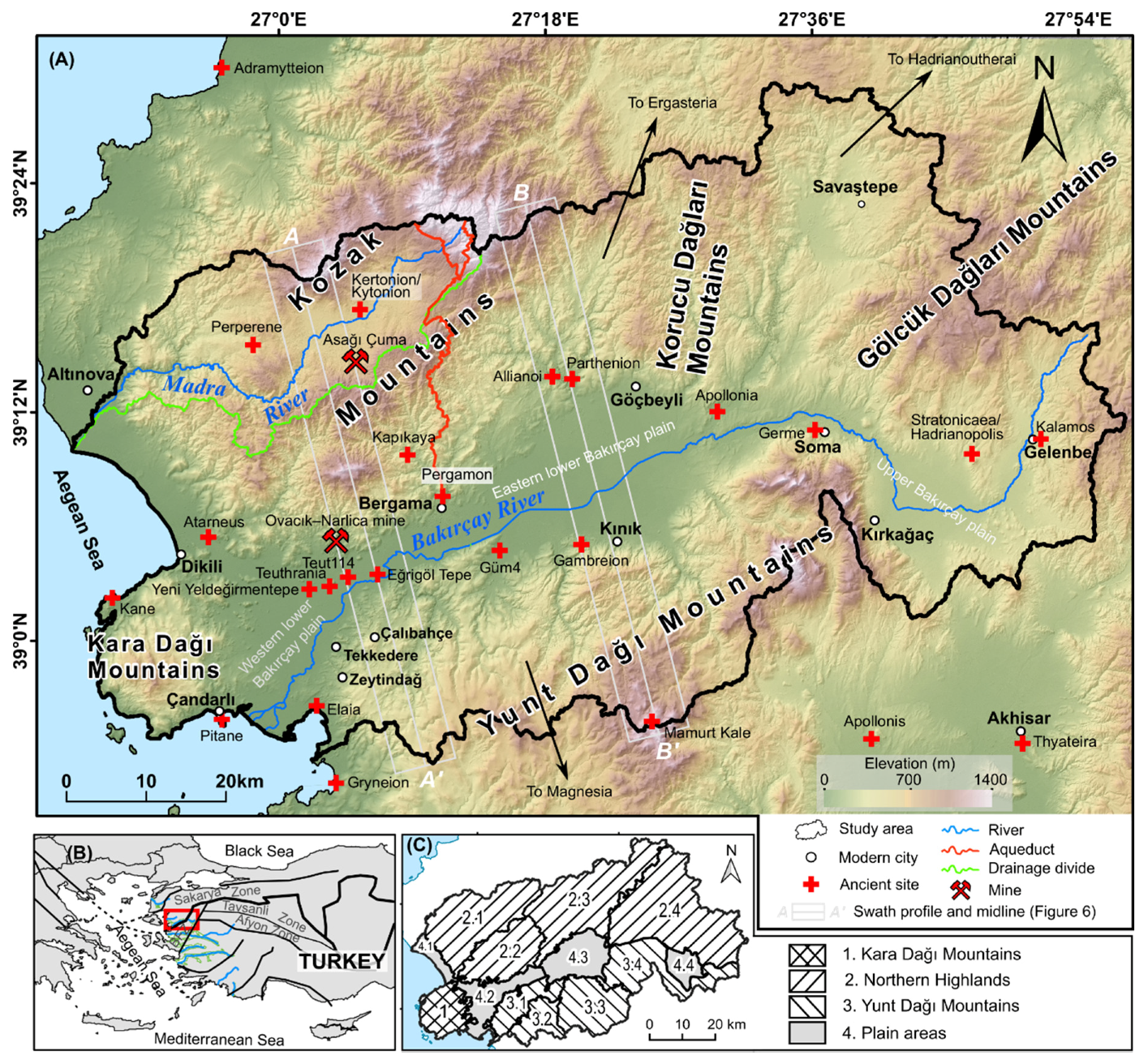
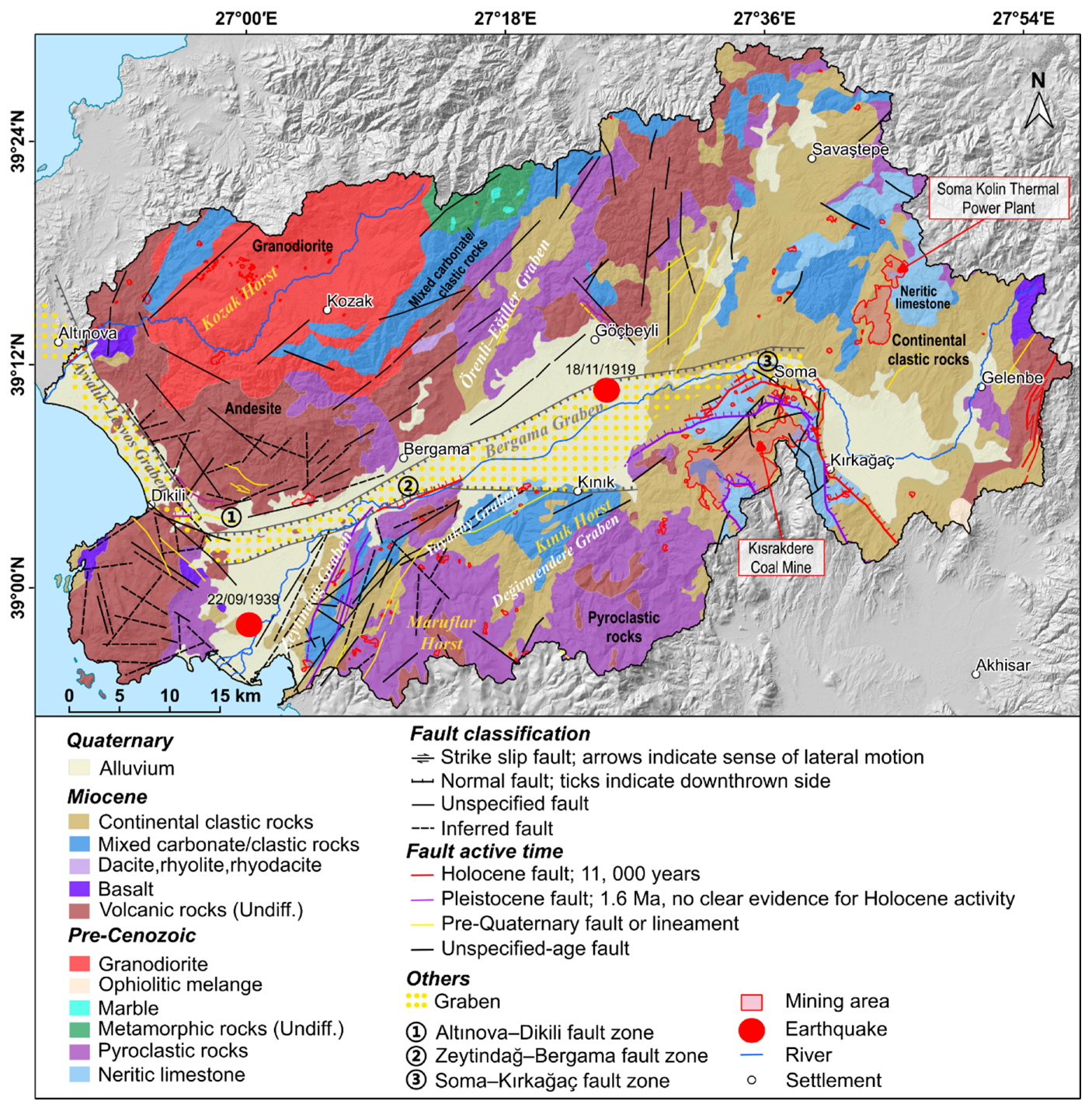
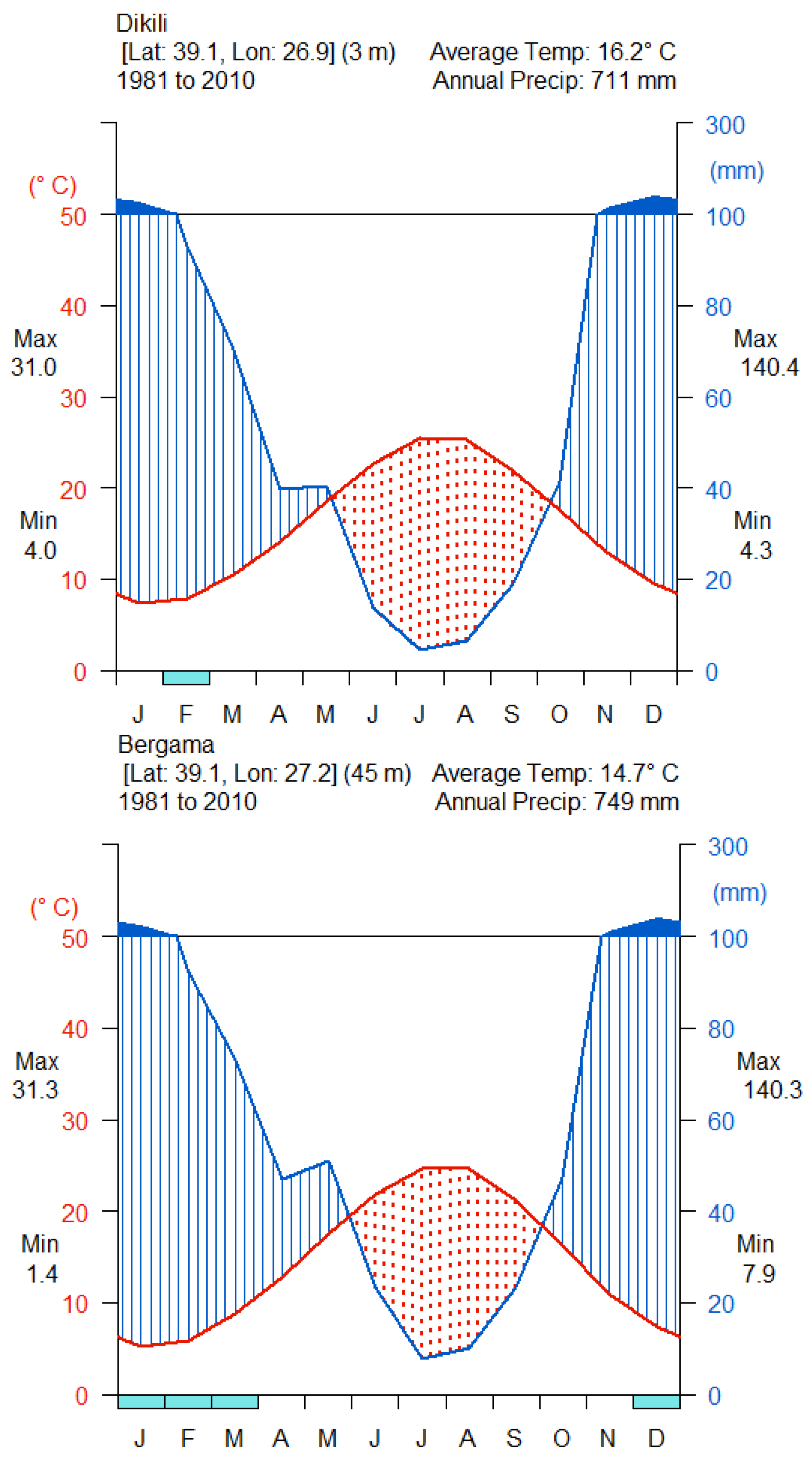
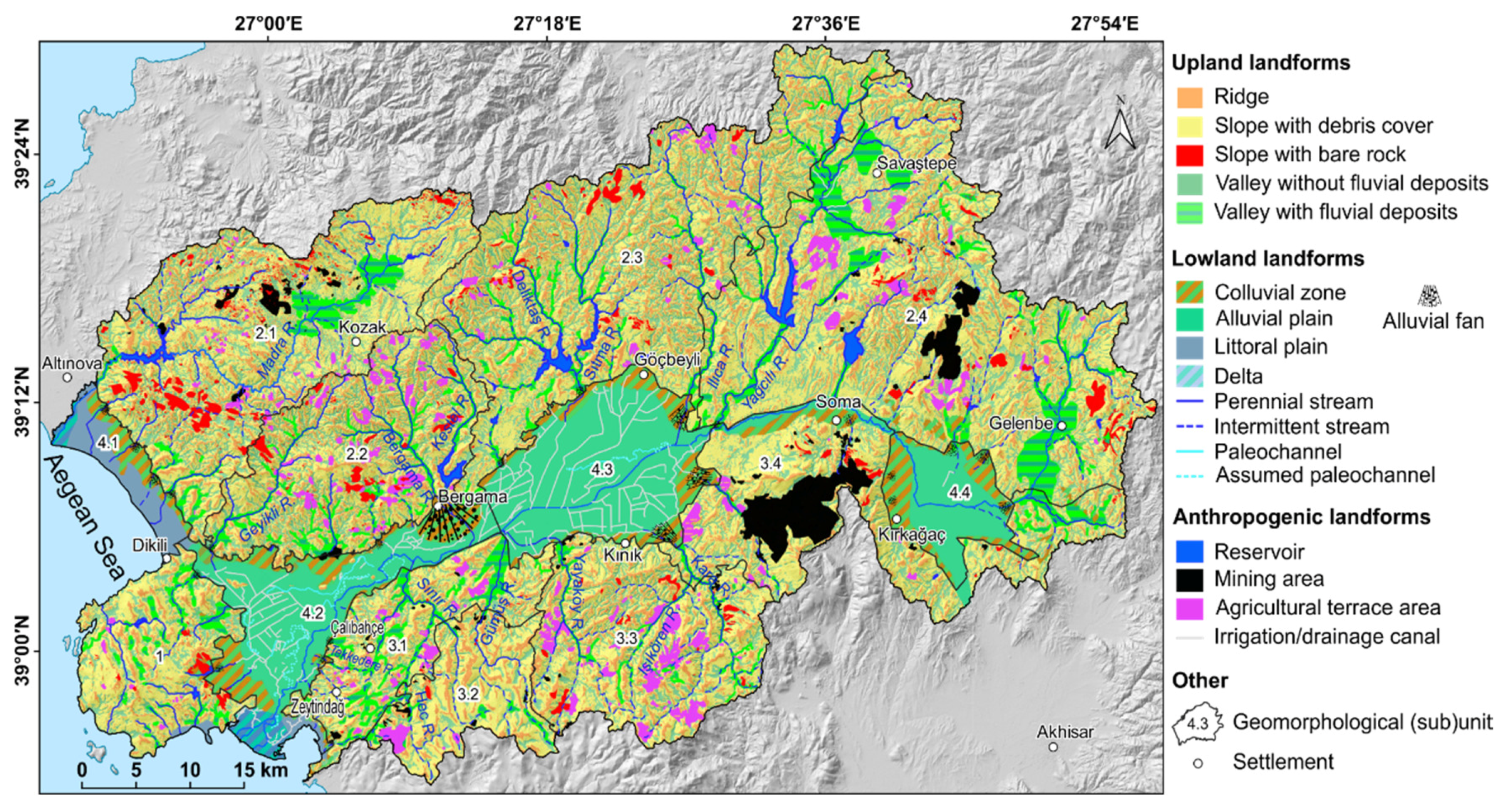
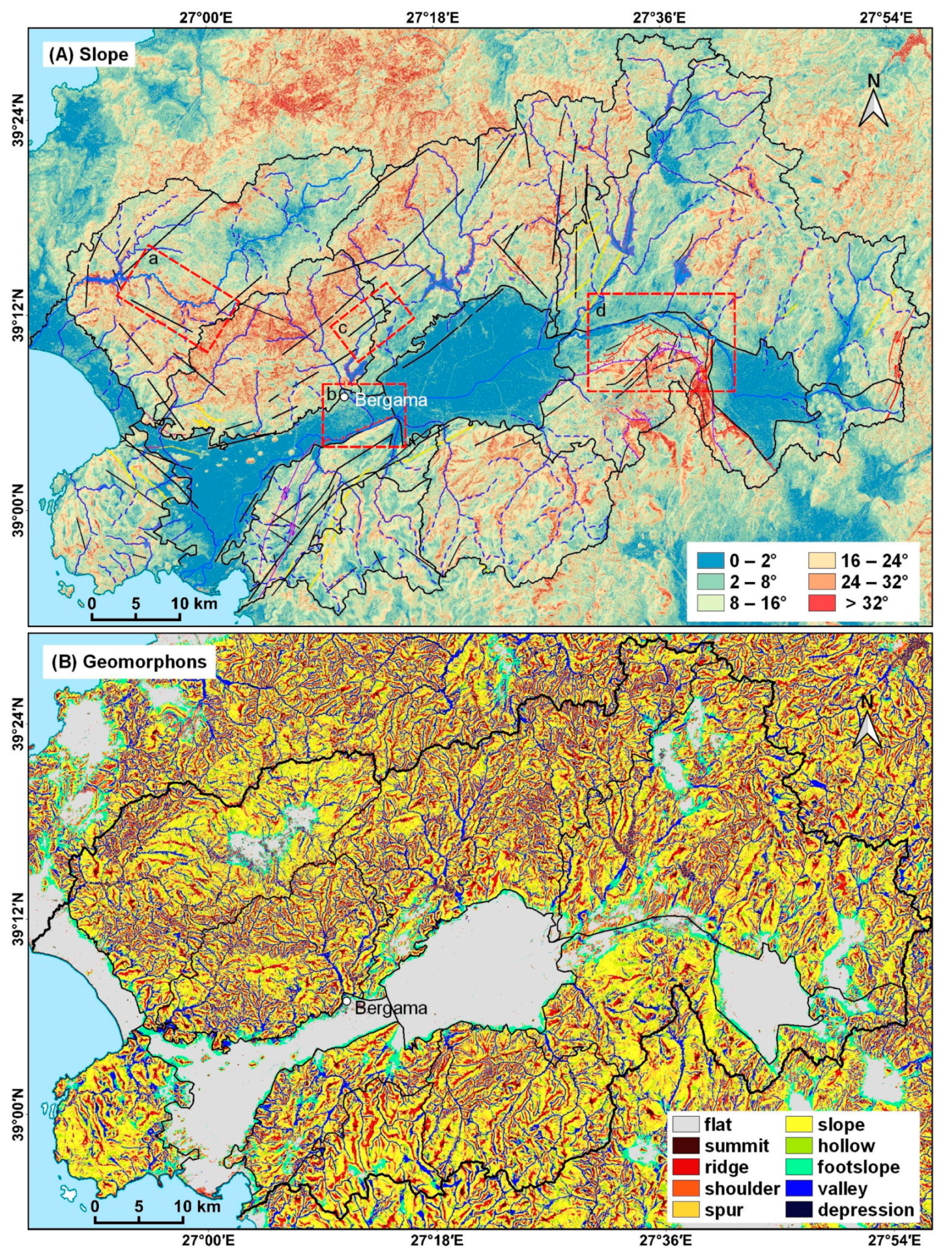


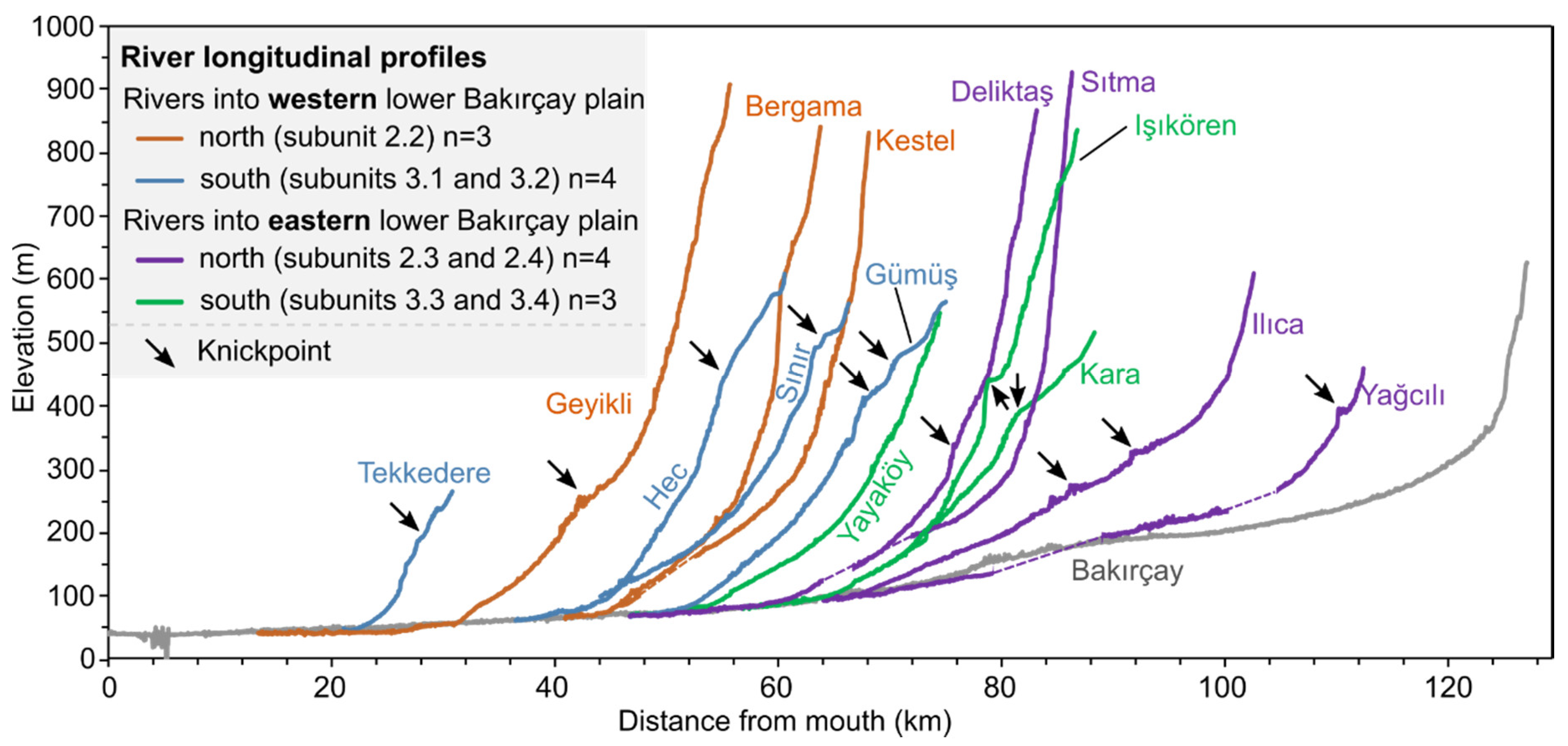
| Derivate | Module | Interpretation |
|---|---|---|
| Shaded relief | Hillshade | Shaded relief representation of the terrain surface. |
| Slope | r.slope.aspect [87] | The slope angle of a raster pixel. |
| Geomorphons | r.geomorphon * [88] | A recognition approach for the classification and mapping of the ten most common landform elements. |
| Aspect | r.slope.aspect [87] | The slope orientation of a raster pixel. |
| Topographic Position Index | topographic position index (TPI) [89,90] | Comparison of each raster pixel’s elevation to the mean elevation of a specified neighborhood around that pixel. |
| Topographic Wetness Index | r.topidx [91,92,93] | The capacity of a raster pixel to accumulate water. |
| Geomorphological (Sub)Units | Area (km2) (Percentage) | Mean Elevation * (m) (Elevation Range (m)) | Slope (°) (σ) | TWI (σ) | |
|---|---|---|---|---|---|
| Total area | 4124 (100%) | 377 (1432) | 11.6 (9) | 6.4 (1.7) | |
| Kara Dağı Mountains | 1 | 198 (5%) | 221 (860) | 11.3 (8) | 6.7 (1.7) |
| Northern Highlands | 2 | 2320 (56%) | 452 (1387) | 13.7 (9) | 6.1 (1.7) |
| 2.1 | 516 (13%) | 529 (1337) | 13.7 (8) | 5.9 (1.7) | |
| 2.2 | 332 (8%) | 437 (1110) | 18.3 (9) | 5.8 (1.7) | |
| 2.3 | 644 (16%) | 436 (1171) | 14.8 (8) | 6.1 (1.6) | |
| 2.4 | 829 (20%) | 423 (880) | 10.9 (8) | 6.5 (1.7) | |
| Yunt Dağı Mountains | 3 | 988 (24%) | 411 (1249) | 12.9 (9) | 6.4 (1.7) |
| 3.1 | 179 (4%) | 187 (423) | 9.6 (6) | 6.6 (1.7) | |
| 3.2 | 145 (4%) | 516 (1038) | 11.1 (7) | 6.2 (1.6) | |
| 3.3 | 310 (8%) | 427 (1152) | 15.5 (8) | 6.4 (1.8) | |
| 3.4 | 354 (9%) | 423 (742) | 12.9 (10) | 6.9 (1.5) | |
| Plain areas | 4 | 618 (15%) | 92 (349) | 1.9 (3) | 6.9 (1.8) |
| 4.1 | 64 (2%) | 53 (183) | 2.1 (3) | 6.9 (1.8) | |
| 4.2 | 219 (5%) | 55 (229) | 2.2 (3) | 6.9 (1.8) | |
| 4.3 | 240 (6%) | 88 (182) | 1.4 (4) | 6.9 (1.7) | |
| 4.4 | 94 (2%) | 213 (133) | 1.7 (2) | 7.0 (1.8) | |
| Location | Lmf (m) | Ls (m) | Smf | Extension of Colluvial Deposits (km) | |
|---|---|---|---|---|---|
| Western lower Bakırçay plain | north | 76.29 | 27.97 | 2.73 | 0.5–2 |
| south | 48.17 | 22.32 | 2.16 | <0.5 | |
| Eastern lower Bakırçay plain | north | 53.83 | 20.11 | 2.68 | <0.5 (west part); 0.5–3 (east) |
| south | 60.80 | 20.29 | 3.00 | ||
Publisher’s Note: MDPI stays neutral with regard to jurisdictional claims in published maps and institutional affiliations. |
© 2021 by the authors. Licensee MDPI, Basel, Switzerland. This article is an open access article distributed under the terms and conditions of the Creative Commons Attribution (CC BY) license (https://creativecommons.org/licenses/by/4.0/).
Share and Cite
Yang, X.; Becker, F.; Knitter, D.; Schütt, B. An Overview of the Geomorphological Characteristics of the Pergamon Micro-Region (Bakırçay and Madra River Catchments, Aegean Region, West Turkey). Land 2021, 10, 667. https://doi.org/10.3390/land10070667
Yang X, Becker F, Knitter D, Schütt B. An Overview of the Geomorphological Characteristics of the Pergamon Micro-Region (Bakırçay and Madra River Catchments, Aegean Region, West Turkey). Land. 2021; 10(7):667. https://doi.org/10.3390/land10070667
Chicago/Turabian StyleYang, Xun, Fabian Becker, Daniel Knitter, and Brigitta Schütt. 2021. "An Overview of the Geomorphological Characteristics of the Pergamon Micro-Region (Bakırçay and Madra River Catchments, Aegean Region, West Turkey)" Land 10, no. 7: 667. https://doi.org/10.3390/land10070667
APA StyleYang, X., Becker, F., Knitter, D., & Schütt, B. (2021). An Overview of the Geomorphological Characteristics of the Pergamon Micro-Region (Bakırçay and Madra River Catchments, Aegean Region, West Turkey). Land, 10(7), 667. https://doi.org/10.3390/land10070667








